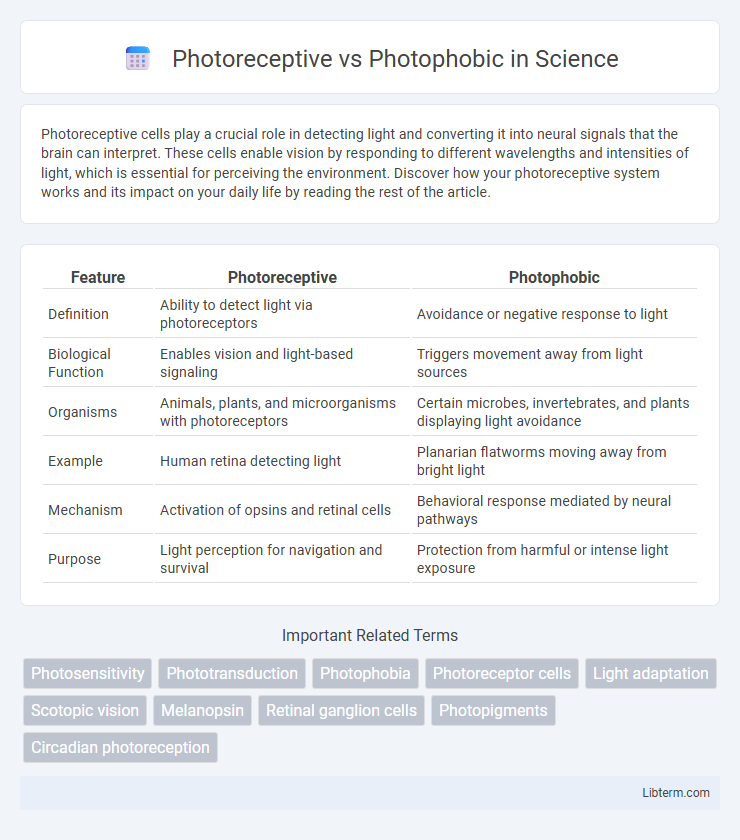Photoreceptive cells play a crucial role in detecting light and converting it into neural signals that the brain can interpret. These cells enable vision by responding to different wavelengths and intensities of light, which is essential for perceiving the environment. Discover how your photoreceptive system works and its impact on your daily life by reading the rest of the article.
Table of Comparison
| Feature | Photoreceptive | Photophobic |
|---|---|---|
| Definition | Ability to detect light via photoreceptors | Avoidance or negative response to light |
| Biological Function | Enables vision and light-based signaling | Triggers movement away from light sources |
| Organisms | Animals, plants, and microorganisms with photoreceptors | Certain microbes, invertebrates, and plants displaying light avoidance |
| Example | Human retina detecting light | Planarian flatworms moving away from bright light |
| Mechanism | Activation of opsins and retinal cells | Behavioral response mediated by neural pathways |
| Purpose | Light perception for navigation and survival | Protection from harmful or intense light exposure |
Introduction to Photoreceptive and Photophobic Responses
Photoreceptive responses involve the detection and reaction to light stimuli by specialized cells or organisms, enabling functions such as vision, circadian rhythm regulation, and phototropism. Photophobic responses are behavioral or physiological reactions that cause an organism to avoid or move away from light sources, often as a survival mechanism to prevent damage from excessive illumination. Understanding the distinction between these responses is essential for studying sensory biology and adaptive behaviors in both plants and animals.
Defining Photoreceptive: Understanding Light Sensitivity
Photoreceptive organisms possess specialized cells or proteins that detect and respond to light stimuli, enabling processes like vision, circadian rhythm regulation, and phototaxis. These cells contain photopigments, such as opsins, which absorb specific light wavelengths to initiate cellular signaling pathways critical for adaptation to environmental light changes. Understanding photoreceptive mechanisms highlights the biological capacity to sense and interpret light, distinguishing it from photophobic behavior, which involves avoidance or negative responses to light exposure.
What Does Photophobic Mean? A Closer Look
Photophobic describes an organism's or cell's tendency to avoid or be negatively affected by light, often resulting in reduced activity or movement away from light sources. This term is commonly used in biology and medicine to indicate light sensitivity, such as in photophobic reactions causing discomfort or damage upon light exposure. Understanding photophobic behavior is crucial in distinguishing it from photoreceptive responses, where organisms actively detect and utilize light for functions like photosynthesis or navigation.
Biological Mechanisms Behind Photoreception
Photoreceptive organisms detect and respond to light through specialized photoreceptor cells containing opsins, which convert light signals into neural impulses, enabling processes like vision and circadian rhythm regulation. Photophobic behavior involves avoidance of light, mediated by neural circuits that trigger movement away from intense illumination to prevent cellular damage or desiccation. The underlying biological mechanisms include differential expression of photopigments and signaling pathways that modulate organismal responses to varying light intensities and wavelengths.
Causes and Symptoms of Photophobia
Photophobia, characterized by an abnormal sensitivity to light, often results from underlying conditions such as migraines, eye inflammation (uveitis), or corneal abrasions that irritate photoreceptive cells in the retina. Symptoms of photophobia include excessive squinting, eye pain, tearing, and discomfort in bright environments, distinguishing it from typical photoreceptive responses that involve normal light detection and adaptation. Understanding the causes and manifestations of photophobia is crucial for accurately diagnosing sensory light sensitivity disorders and implementing effective treatment plans.
Photoreception Across Different Organisms
Photoreception enables organisms to detect and respond to light, driving behaviors such as navigation, foraging, and predator avoidance. Photoreceptive organisms, including plants, animals, and microorganisms, use specialized cells or proteins like opsins to sense light intensity and wavelength. In contrast, photophobic responses involve movement away from harmful or intense light stimuli, commonly observed in certain bacteria, insects, and some amphibians as a survival mechanism.
Factors Triggering Photophobic Behavior
Photophobic behavior is triggered primarily by intense or harmful light stimuli that overwhelm photoreceptive systems, causing discomfort or avoidance responses. Factors such as sudden exposure to bright light, ultraviolet radiation, and high luminance levels can activate photophobic mechanisms. This sensitivity often serves as a protective response to prevent retinal damage or neurological stress linked to excessive light exposure.
Adaptive Functions: Advantages of Photoreceptive and Photophobic Traits
Photoreceptive traits enable organisms to detect and respond to light stimuli, enhancing navigation, foraging efficiency, and predator avoidance in diverse environments. Photophobic traits drive avoidance of light, providing survival advantages in habitats where light exposure increases predation risk or environmental stress, such as ultraviolet radiation damage. Both adaptations optimize organismal fitness by regulating behavior according to light conditions, contributing to ecological niche specialization and evolutionary success.
Medical and Environmental Implications
Photoreceptive disorders, such as photophobia, involve heightened sensitivity to light causing discomfort or pain, often linked to migraines, meningitis, or ocular conditions like uveitis. Photophobic responses can lead to behavioral adaptations, including avoidance of bright environments, which may impact mental health and quality of life. Environmental factors, including artificial lighting and screen exposure, exacerbate these conditions, emphasizing the need for medical interventions and ergonomic lighting solutions to mitigate symptoms.
Conclusion: Balancing Light Sensitivity in Nature and Health
Photoreceptive organisms harness light for essential processes like photosynthesis and vision, while photophobic species actively avoid intense light to prevent damage or stress. Balancing light sensitivity is crucial for maintaining ecological rhythms, supporting biodiversity, and ensuring human health by managing conditions such as photophobia and circadian rhythm disorders. Effective strategies include adaptive behaviors, evolutionary traits, and therapeutic interventions that optimize light exposure for survival and well-being.
Photoreceptive Infographic

 libterm.com
libterm.com